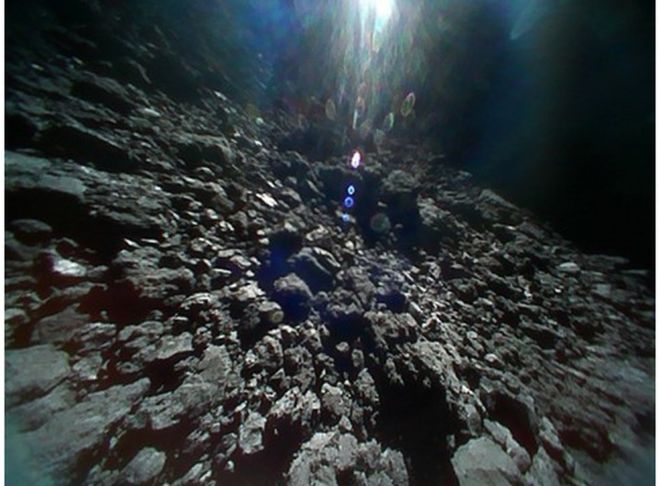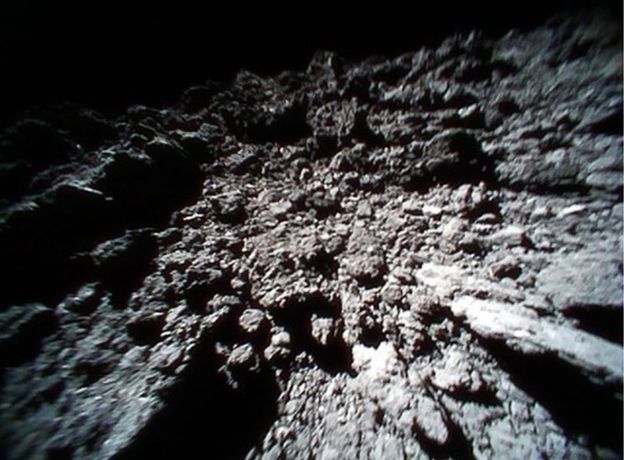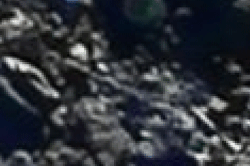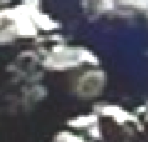It looks like you're using an Ad Blocker.
Please white-list or disable AboveTopSecret.com in your ad-blocking tool.
Thank you.
Some features of ATS will be disabled while you continue to use an ad-blocker.
share:
originally posted by: charlyv
Is this a retrieval operation as well? Will they get samples, and return them to Hayabusa2 for analysis, or better yet, will they be able to somehow get samples back to Earth?
Yes, and it's a very fancy operation.
Hayabusa2's sampling device is similar to Hayabusa's. In late October 2018, the spacecraft will approach the surface of the asteroid with a sampling horn. When the horn touches the surface, a projectile (5-gram tantalum bullet) will be fired at 300 m/s into the surface. The resulting ejecta particles are collected by a catcher at the top of the horn, which the ejecta will reach under their own momentum under microgravity conditions.
Subsurface samples
An additional sample will be taken of material deeper into the subsurface, which has not been subjected to space weathering. This requires removing a larger volume of surface material with a more substantial impactor. For this purpose, Hayabusa2 will deploy the Small Carry-on Impactor (SCI), a kinetic impactor consisting of a 2.5 kg (5.5 lb) copper projectile with an explosive propellant charge. After the spacecraft is at a safe distance, the penetrator will be fired into the asteroid surface by the detonation of 4.5 kg (9.9 lb) shaped charge of plasticized HMX for acceleration. SCI will be shot to the surface from an altitude of about 500 meters.
Following SCI deployment, Hayabusa2 will leave behind a deployable camera (DCAM3) to observe and map the precise location of the SCI impact, while maneuvering to the far side of the asteroid in order to avoid debris from the impact. Approximately 40 minutes after separation, SCI will be fired and drive the copper impactor onto the asteroid, and is expected to excavate a crater of about 2 meters in diameter and expose pristine material. Hayabusa2 will wait about two weeks for the debris to clear from the impact site, before descending into the newly-formed crater to retrieve samples.
At the end of the science phase in December 2019, Hayabusa2 will use its ion engines for changing orbit and return to Earth. In December 2020, the re-entry capsule with three separate containers that carry the asteroid samples will be released to re-enter Earth's atmosphere at 12 km/second, while the spacecraft drifts past Earth.
en.wikipedia.org...
a reply to: DexterRiley
That is really some piece of robotic technology for sure. Comets like this one are the source of carbonaceous chondrite meteorites found on Earth. Many have amino acids which are precursors of life. There have even been signs of fossilized bacteria, but since they have been on the Earth so long, the possibility of contamination is really huge.
Many scientists believe that some inner solar system comets are an amalgam of oceans and crust of a destroyed planet in our early solar system.
Imagine if the returned samples contained the same fossilized bacteria... All this time exploring Mars and then being scooped by a comet!
That is really some piece of robotic technology for sure. Comets like this one are the source of carbonaceous chondrite meteorites found on Earth. Many have amino acids which are precursors of life. There have even been signs of fossilized bacteria, but since they have been on the Earth so long, the possibility of contamination is really huge.
Many scientists believe that some inner solar system comets are an amalgam of oceans and crust of a destroyed planet in our early solar system.
Imagine if the returned samples contained the same fossilized bacteria... All this time exploring Mars and then being scooped by a comet!
edit on 23-9-2018 by charlyv because: spelling , where caught
a reply to: charlyv
If they were to find fossilized bacteria in the returned samples, scientists would debate the validity of the analysis for a decade or more. They wouldn't be satisfied until they sent another return mission to acquire more samples. Even then there will still be skeptics.
But the implications of such a find are mind-boggling; a true scientific black swan event. There would be widespread adjustment, if not outright refutation, of a number of scientific theories across a host of different fields. Not the least of which would include parts of the theory of evolution.
However, even in the absence of such a major discovery, I'm sure the return samples will raise as many questions as answers.
-dex
Imagine if the returned samples contained the same fossilized bacteria... All this time exploring Mars and then being scooped by a comet!
If they were to find fossilized bacteria in the returned samples, scientists would debate the validity of the analysis for a decade or more. They wouldn't be satisfied until they sent another return mission to acquire more samples. Even then there will still be skeptics.
But the implications of such a find are mind-boggling; a true scientific black swan event. There would be widespread adjustment, if not outright refutation, of a number of scientific theories across a host of different fields. Not the least of which would include parts of the theory of evolution.
However, even in the absence of such a major discovery, I'm sure the return samples will raise as many questions as answers.
-dex
The paradox is true. Even if ET walked into the UN and said "Here we are", they would probably claim it was a mass hallucination. Bacteria does not
have a chance, I guess.
a reply to: charlyv
The same is equally true of UFO and alien devotees. No matter how many times you tell them that the thing they are claiming is alien in origin is something commonplace with a very simple explanation, right down with conclusive pictures and diagrams, they will still stick with their original preferred explanation.
Discovering life, or evidence of life, in this asteroid (NB asteroid, not a comet), would rightly require rigorous and thorough examination before anyone jumped the gun and claimed a false positive too quickly. That's exactly how kooks exaggerate a story and claim that the 'truth' is being hidden when it gets proved to be incorrect.
The same is equally true of UFO and alien devotees. No matter how many times you tell them that the thing they are claiming is alien in origin is something commonplace with a very simple explanation, right down with conclusive pictures and diagrams, they will still stick with their original preferred explanation.
Discovering life, or evidence of life, in this asteroid (NB asteroid, not a comet), would rightly require rigorous and thorough examination before anyone jumped the gun and claimed a false positive too quickly. That's exactly how kooks exaggerate a story and claim that the 'truth' is being hidden when it gets proved to be incorrect.
a reply to: OneBigMonkeyToo
Agree that passing something through the scientific gauntlet and having it emerge relatively unscathed is a very rare occurrence, and rightfully so. There are a lot of crazy theories and crazier people to go with them...
Science is showing that asteroids and comets have a lot in common, especially the parts that represent crustal materials. Big differences here are amounts of carbon, water and methane. We have actually witnessed some 'asteroids' to start ablating material as they get close to the sun. The material that they find in this 'asteroid' will be very important as it has a very low libido, which may be an indication of organic content, like the source of CC meteorites.
Agree that passing something through the scientific gauntlet and having it emerge relatively unscathed is a very rare occurrence, and rightfully so. There are a lot of crazy theories and crazier people to go with them...
Science is showing that asteroids and comets have a lot in common, especially the parts that represent crustal materials. Big differences here are amounts of carbon, water and methane. We have actually witnessed some 'asteroids' to start ablating material as they get close to the sun. The material that they find in this 'asteroid' will be very important as it has a very low libido, which may be an indication of organic content, like the source of CC meteorites.
edit on 24-9-2018 by charlyv because: spelling , where caught
originally posted by: charlyv
The material that they find in this 'asteroid' will be very important as it has a very low libido, which may be an indication of organic content, like the source of CC meteorites.
(Emphasis added)
It could also mean it's getting on in years, if nothing else.
(I'm pretty sure you meant albedo)
originally posted by: Saint Exupery
originally posted by: charlyv
The material that they find in this 'asteroid' will be very important as it has a very low libido, which may be an indication of organic content, like the source of CC meteorites.
(Emphasis added)
It could also mean it's getting on in years, if nothing else.
(I'm pretty sure you meant albedo)
Yea, thanks.
Great Freudian slip word!!
I am having troubles uploading today (get the Gallery but the Upload button is not accessible). I have copies of the pics that I will post when I am
able to.
There are several pictures from the surface. On their twitter feed, they put up a 15 fps "movie" from the surface!
Both pics and twitter video are on this article.
BBC.com, science - Hayabusa 2 rovers send new images from Ryugu surface.
Direct twitter link, hayabusa2@JAXA: twitter.com...
It is surreal to say the least! Like being on the bottom of the ocean. Trippy!
There are several pictures from the surface. On their twitter feed, they put up a 15 fps "movie" from the surface!
Both pics and twitter video are on this article.
BBC.com, science - Hayabusa 2 rovers send new images from Ryugu surface.
Direct twitter link, hayabusa2@JAXA: twitter.com...
It is surreal to say the least! Like being on the bottom of the ocean. Trippy!
originally posted by: TEOTWAWKIAIFF
There are several pictures from the surface. On their twitter feed, they put up a 15 fps "movie" from the surface!
[...]
It is surreal to say the least! Like being on the bottom of the ocean. Trippy!
I swear I see a tiny little pyramid on that rock.
a reply to: TEOTWAWKIAIFF
It's beautiful. People are squabbling over everything down here and they're way out there doing their thing.
It's beautiful. People are squabbling over everything down here and they're way out there doing their thing.
a reply to: Blue Shift
Funny how that works out!
And the whole thing is weird shaped as well like a fuzzy die. You would think that left to its own and the force of gravity it would be more roundish. But looking at the returns from 'Oumouma, seems universe can do what ever she wants to! Why not a pyramid on dice-shaped asteroid?
eta, correction: It is not "15 fps" as I stated earlier. It is 15 frames stitched together.
Funny how that works out!
And the whole thing is weird shaped as well like a fuzzy die. You would think that left to its own and the force of gravity it would be more roundish. But looking at the returns from 'Oumouma, seems universe can do what ever she wants to! Why not a pyramid on dice-shaped asteroid?
eta, correction: It is not "15 fps" as I stated earlier. It is 15 frames stitched together.
originally posted by: Kandinsky
a reply to: TEOTWAWKIAIFF
It's beautiful. People are squabbling over everything down here and they're way out there doing their thing.
No people there.
a reply to: Blue Shift
It's cool sometimes to get away from everyone and watch the sea and the stars. Imagine being perched on an asteroid looking out on the next best thing to infinity?
Probably a challenge lighting a campfire out there.
It's cool sometimes to get away from everyone and watch the sea and the stars. Imagine being perched on an asteroid looking out on the next best thing to infinity?
Probably a challenge lighting a campfire out there.
a reply to: TEOT's upload issue post
There is something blocking the "Upload" button. It is invisible but still renders as an "object" preventing me from selecting the Upload button (cursor dose not change to Finger but stays as Point-y-Arrow-thing).
Solution: Expand browser to the whole screen!
Photos from JAXA from the BBC article:
First

There is something blocking the "Upload" button. It is invisible but still renders as an "object" preventing me from selecting the Upload button (cursor dose not change to Finger but stays as Point-y-Arrow-thing).
Solution: Expand browser to the whole screen!
Photos from JAXA from the BBC article:
First


Interesting stuff.




edit on 27-9-2018 by Blue Shift because: (no reason given)
new topics
-
Well this is Awkward .....
Mainstream News: 43 minutes ago -
Kurakhove officially falls. Russia takes control of major logistics hub city in the southeast.
World War Three: 1 hours ago -
Liberal Madness and the Constitution of the United States
US Political Madness: 7 hours ago
top topics
-
New York Governor signs Climate Law that Fines Fossil Fuel Companies
US Political Madness: 15 hours ago, 18 flags -
Liberal Madness and the Constitution of the United States
US Political Madness: 7 hours ago, 8 flags -
Well this is Awkward .....
Mainstream News: 43 minutes ago, 8 flags -
Kurakhove officially falls. Russia takes control of major logistics hub city in the southeast.
World War Three: 1 hours ago, 5 flags
active topics
-
Well this is Awkward .....
Mainstream News • 1 • : Bluntone22 -
Meta Llama local AI system is scary good
Science & Technology • 29 • : huntedTheory -
Cold Blooded Killers on Christmas!! GRRRRrrr!!
Pets • 15 • : GENERAL EYES -
U.S. President JOE BIDEN Has Spent a Staggering 40 Percent of His Term On VACATION!.
Political Ideology • 57 • : WeMustCare -
BIden Took 48 Years Worth of Vacation While President
Politicians & People • 28 • : WeMustCare -
Plane Crash Today --Azerbaijanian E190 passenger jet
Mainstream News • 40 • : GENERAL EYES -
New York Governor signs Climate Law that Fines Fossil Fuel Companies
US Political Madness • 23 • : GENERAL EYES -
Trump says ownership of Greenland 'is an absolute necessity'
Other Current Events • 56 • : cherokeetroy -
UK Borders are NOT Secure!
Social Issues and Civil Unrest • 16 • : angelchemuel -
Elon Musk futurist?
Dreams & Predictions • 17 • : GENERAL EYES
